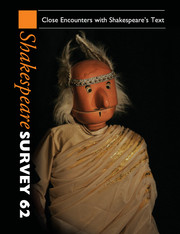Book contents
- Frontmatter
- Shakespeare, text and paratext
- The popularity of Shakespeare in print
- The continuing importance of new Bibliographical method
- ‘Honour the real thing’: Shakespeare, Trauma and Titus Andronicus in South Africa
- ‘O, these encounterers’: on Shakespeare’s meetings and partings
- A play of modals: Grammar and potential action in early Shakespeare
- Merry, marry, Mary: Shakespearian wordplay and Twelfth Night
- A subtle point: Sleeves, tents and ‘Ariachne’s broken woof’ (again)
- The look of Othello
- Red button Shakespeare
- ‘Mark you / his absolute shall?’: Multitudinous tongues and contested words in Coriolanus
- Chagall’s Tempest: An autobiographical reading
- Reading illustrated editions: Methodology and the limits of interpretation
- Close encounters with Anne Brontë's Shakespeare
- Shakespeare and the magic lantern
- Shakespeare and the coconuts: close encounters in post-apartheid South Africa
- The Schrödinger effect: Reading and misreading performance
- Behind the scenes
- Inner monologues: Realist acting and/as Shakespearian performance text
- More japanized, casual and transgender shakespeares
- Translation futures: Shakespearians and the foreign text
- After translation
- ‘The single and peculiar life’: Hamlet’s heart and the early modern subject
- Mapping King Lear
- ‘Last on the stage’: The place of Shakespeare in Charles Darwin’s ethology
- Sense/memory/sense-memory: Reading narratives of Shakespearian rehearsals
- Shakespeare performances in England (and Wales), 2008
- Professional Shakespeare productions in the British Isles, January–December 2007
- The Year's Contributions to Shakespearian Study 1 Critical Studies
- 2 Shakespeare in performance
- 3a Editions and textual studies
- 3b Editions and textual studies
- Index to Volume 62
Inner monologues: Realist acting and/as Shakespearian performance text
Published online by Cambridge University Press: 28 November 2009
- Frontmatter
- Shakespeare, text and paratext
- The popularity of Shakespeare in print
- The continuing importance of new Bibliographical method
- ‘Honour the real thing’: Shakespeare, Trauma and Titus Andronicus in South Africa
- ‘O, these encounterers’: on Shakespeare’s meetings and partings
- A play of modals: Grammar and potential action in early Shakespeare
- Merry, marry, Mary: Shakespearian wordplay and Twelfth Night
- A subtle point: Sleeves, tents and ‘Ariachne’s broken woof’ (again)
- The look of Othello
- Red button Shakespeare
- ‘Mark you / his absolute shall?’: Multitudinous tongues and contested words in Coriolanus
- Chagall’s Tempest: An autobiographical reading
- Reading illustrated editions: Methodology and the limits of interpretation
- Close encounters with Anne Brontë's Shakespeare
- Shakespeare and the magic lantern
- Shakespeare and the coconuts: close encounters in post-apartheid South Africa
- The Schrödinger effect: Reading and misreading performance
- Behind the scenes
- Inner monologues: Realist acting and/as Shakespearian performance text
- More japanized, casual and transgender shakespeares
- Translation futures: Shakespearians and the foreign text
- After translation
- ‘The single and peculiar life’: Hamlet’s heart and the early modern subject
- Mapping King Lear
- ‘Last on the stage’: The place of Shakespeare in Charles Darwin’s ethology
- Sense/memory/sense-memory: Reading narratives of Shakespearian rehearsals
- Shakespeare performances in England (and Wales), 2008
- Professional Shakespeare productions in the British Isles, January–December 2007
- The Year's Contributions to Shakespearian Study 1 Critical Studies
- 2 Shakespeare in performance
- 3a Editions and textual studies
- 3b Editions and textual studies
- Index to Volume 62
Summary
In Declan Donnellan's 2008 production of Troilus and Cressida for Cheek by Jowl, Helen of Troy (Marianne Oldham) initially featured as the Face that Launched a Thousand Copies of Hello! Magazine. Decked in a chic white evening gown, she delivered the play's Prologue while stalking with feline satisfaction among the soldiers who would die for her (illustration 48). Later, she and Paris primped and posed for a series of glamour photos, looking for all the world like a Shakespearian Brad Pitt and Angelina Jolie. When Pandarus began his song, 'Love, love, nothing but love', Helen proved her star power by joining her voice with his, offering, one critic asserted, 'the best singing of the night'. At this point, however, something surprising happened. The song's lascivious words seemed increasingly to disturb her; her voice began to tremble, her eyes filled with tears, and by the end of the song she had to pause to compose herself. Soon the mask cracked altogether and she broke weeping from the stage. The audience had witnessed Helen's transformation from a plastic icon into a psychologically complex 'character' in the realist tradition.
Depending on one's perspective, such an approach to Helen may appear either self-evident or thoroughly wrong-headed. Some version of realist acting informs most mainstream American and British productions of Shakespeare and his contemporaries. Its shaping force guarantees that many actors and directors will explore the inner objectives and past histories that drive their characters' words and actions, creating complex emotional subtexts to flow beneath the complex Shakespearian text. Moreover, many audience members will judge the resulting performances as much or even more in terms of the richness, plausibility and clarity of their implied emotional narratives as in terms of any relationship to the literary play-text. Yet this process has come under increasing fire from scholars, who have branded it ahistorical, apolitical and insufficiently conscious of its own tortuous relationship to the perceived authority of the Shakespearian text.
- Type
- Chapter
- Information
- Shakespeare Survey , pp. 249 - 260Publisher: Cambridge University PressPrint publication year: 2009

